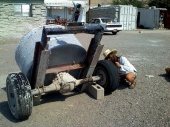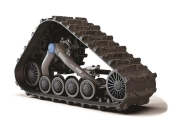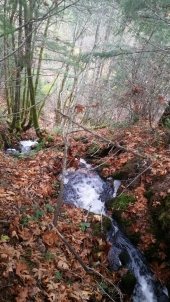
























 That sensitivity is another reason to look for pre-computer era machines. I can't spend much time near that many servo motors at once. Messes with my blood pressure.
That sensitivity is another reason to look for pre-computer era machines. I can't spend much time near that many servo motors at once. Messes with my blood pressure. 




Dale Hodgins wrote: In searching out old tractors I've discovered that many "parts tractors" have a good engine and transmission but are not economic to fix up completely. Some have sustained steering damage, some have lost their body metal and many go cheap because they have bad rubber. A decent running Ford 8n in my area goes for $2500 with attachments. But a perfectly good unit with bad rubber and no toys goes for $500. This is much less than I would expect to pay for a 20+ hp stationary engine. I could see mounting an old tractor on concrete piers and using not only the power take-off but also utilizing the suspended rear wheels as power sources. The wheels would be suspended a foot off the ground with the front anchored in concrete as well.
All of this and more can be accomplished using a good old "parts tractor" as a stationary engine.
Please submit other ideas on what you would do with this sort of power source.

 1
1









Kent












Alan Attaboy wrote:
Dale Hodgins wrote: In searching out old tractors I've discovered that many "parts tractors" have a good engine and transmission but are not economic to fix up completely. Some have sustained steering damage, some have lost their body metal and many go cheap because they have bad rubber. A decent running Ford 8n in my area goes for $2500 with attachments. But a perfectly good unit with bad rubber and no toys goes for $500. This is much less than I would expect to pay for a 20+ hp stationary engine. I could see mounting old tractor paint on concrete piers and using not only the power take-off but also utilizing the suspended rear wheels as power sources. The wheels would be suspended a foot off the ground with the front anchored in concrete as well.
All of this and more can be accomplished using a good old "parts tractor" as a stationary engine.
Please submit other ideas on what you would do with this sort of power source.
This is an excellent way to source parts through unconventional means so thanks for sharing.
Here's my spin on this issue:
I was planning on buying a 20+ HP engine to power a home built bandsaw lumbermill and also a home built well drilling unit. The lumbermill to be used to process timber to build a house, barn, fences, and ancillary buildings, the well drilling unit to drill for water and to drill a number of vertical shafts for a ground sourced heat pump. I live in the same city as you and the local drillers are charging about $20 a foot for their services.
My idea is to invest money in equipment that would otherwise be spent on labor for the services provided by other people - pay for lumber or pay for equipment and get the lumber for free, pay $20,000 for well drilling or pay $4,000 for equipment and drill multiple wells (water and GSHP). I'll be using the lumbermill more frequently than the drilling unit, so why not design the units so that the engine can be swapped between them - that way I don't have a dedicated engine on each unit not being used to its fullest extent.
The parts value of the dilapidated tractor likely exceeds the standing value of the tractor. Pick up such a unit, strip it, maybe even use parts of the tractor frame in the build of the lumber mill and drilling unit.

|
Two tiny ads walk into a bar. The bartender says:
Learn Permaculture through a little hard work
https://wheaton-labs.com/bootcamp
|








